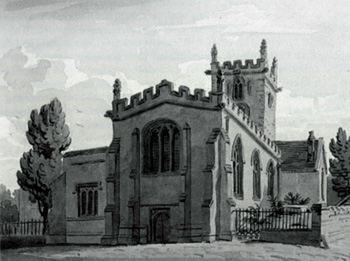
Saint Mary's by Thomas Fisher about 1815
Former County Archivist Chris Pickford wrote a series for Bedfordshire Historical Record Society on Bedfordshire churches in the 19th century, from which this article is partially derived. After the creation of the north aisle about 1545 the next known work on the church was in the 18th century when a number of memorials were erected both in the church and the churchyard. A peel of six bells was in place by 1748. Extensive repairs took place in 1804 as indicated by the rainwater heads on the south side of the nave. The nave was re-roofed with tiles instead of lead and was ceiled inside. In the glebe terrier of 1822 the church was described as being 111 feet long (including the chancel) and 30 feet wide; the tower stood to a height of 60 feet.
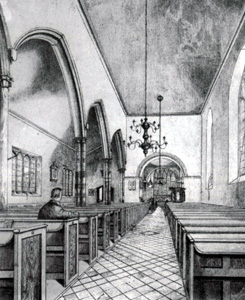
Saint Mary's interior looking east by John Sunman Austin in 1851 [ref: X56/34]
In 1834 Bedford architect James Tacy Wing drew up plans for restoring the west front and at that time the tracery in the west window was altered to match that in the new south windows in the aisle. In 1842 Wing rebuilt the north arcade and put new seating in the nave and aisle amongst other work. In 1851 the south aisle with its arcade of four columns was inserted to match the north aisle as well as a new north porch and vestry to the north of the chancel. The new chancel east window was inserted in 1874 and the chancel re-roofed twelve years later. The vestry was remodelled by George Grocock in 1908 and the nave re-roofed, again, in 1912 after the plaster ceiling of 1804 collapsed.
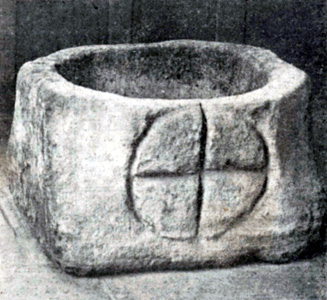
A font presented to Saint Mary's in 1937
In 1937 the local press reported an unusual gift: "Through the kindness of Mr. H. Wyatt St. Mary's Church, Bedford, has acquired the historic font of the Church of St. Peter de Dunstable, which formerly stood in St. Mary's Square and was demolished in 1545. The font, which was used as a horse-trough in the yard of the "Angel" inn, Cauldwell Street, until it was rescued by the late Rev. P. Wyatt, stood in the latter's garden for some thirty years. The font, which is in the Perpendicular style, has suffered considerably from long exposure to the weather and the original ornamentation has disappeared. The cross within a circle carved on the font was probably added during the period of its desecration in order that its ecclesiastical character might be preserved" [ref: X56/40].
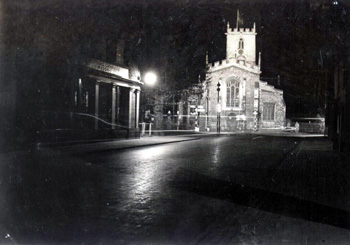
Saint Mary's Bedford 1937 [ref: X56/40]
Coincidentally the same scrapbook which mentions the acquisition of the font has a cutting from the same year about thefts from churches: "Kneeling down at the altar, a man who had robbed offertory boxes in Bedford churches, hoped to allay any suspicion when P. C. Frost of the Borough Police Force, entered St. Mary's Church to interview him. The constable waited until the thief had finished his prayers, questioned him, arrested him, and yesterday he received six months hard labour at the Borough Police Court".
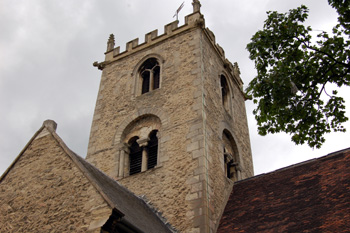
Saint Mary's tower seen from the south, June 2009
In 1938 and 1958 further restoration was undertaken, the latter including the tower. The church was closed in 1975 and declared redundant. The parish was united with that of Saint Paul. In 1981 the church was given to the Redundant Churches Fund and in 1990, after suitable alterations, it became the home of the county archaeological service, since renamed Albion Archaeology, a use it retains at the time of writing [2009]. The bells were transferred to Saint Andrew's church, Bedford, shortly after the church was closed.